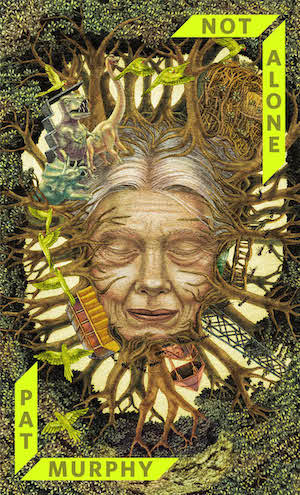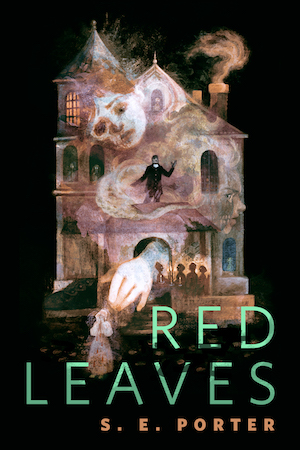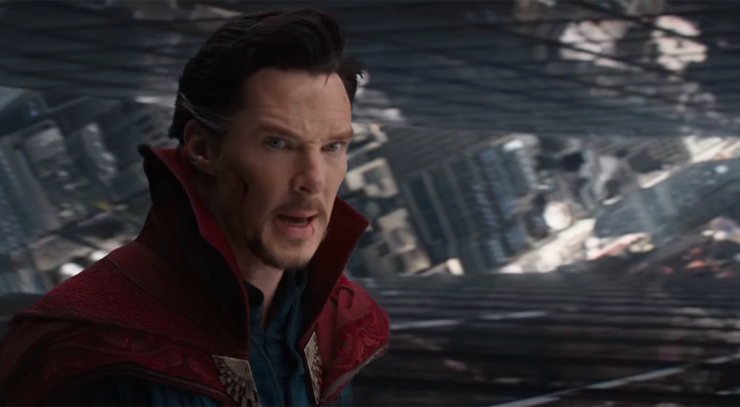In the early 1960s, Steve Ditko—one of the many artists working for Marvel, and co-creator of Spider-Man with Stan Lee—went to Lee with the notion of a superhero who used magic and spellcraft to fight the bad guys, inspired in part by the old radio show Chandu the Magician. Since the character was to appear as a backup feature in Strange Tales, they decided to call him Dr. Strange (since calling him Mr. Strange would be too much like Mr. Fantastic in Fantastic Four).
He quickly became a mainstay of the Marvel Universe, adapted into a TV movie in 1978 and then brought into the Marvel Cinematic Universe 38 years later.
Ditko’s magnificently psychedelic artwork combined with Lee’s perfect ear for ostentatious dialogue to make Dr. Strange into a cult hit, quickly taking over the front of Strange Tales, which went from monster comic, to comic featuring the Human Torch, to a double feature of Strange and Nick Fury, Agent of S.H.I.E.L.D. Eventually, Fury was spun off into his own comic and Strange Tales was retitled Doctor Strange.
Strange has occupied an odd place in Marvel Comics lore. He’s only occasionally been able to support his own title. Doctor Strange was cancelled in 1969, though he then appeared in Marvel Feature, in which he joined with the Hulk, the Sub-Mariner, and the Silver Surfer to form the “non-team” the Defenders, who continued, with Strange as a regular presence, into the mid-1980s. He again got his own series in the 1970s and 1980s, and then shared a new version of Strange Tales with Cloak & Dagger. In the twenty-first century, Strange has been part of the Secret Defenders and various incarnations of the Avengers, consistently acting as the sorcerer supreme of Earth, and master of the mystic arts.
Strange is another Marvel character who bounced around from studio to studio, including New World, Regency, Savoy Pictures, Columbia Pictures, Dimension Pictures, Miramax, Paramount, and finally settling at Marvel Studios. At various times the following were all attached to (or at least pitching) a Doctor Strange film: Alex Cox, Wes Craven, Benecio del Toro, Michael France, Neil Gaiman, Bob Gale, David S. Goyer, Stephen Norrington, Chuck Russell, and Jeff Welch.
Scott Derrickson lobbied hard to be chosen as director, going so far as to write and storyboard a twelve-page sequence based on Doctor Strange: The Oath, which was later used in the final film. Derrickson worked with his collaborator C. Robert Cargill, with Marvel hiring Jon Spaihts for rewrites, which were done in consultation with Derrickson.
The story followed the basics of Strange’s comics origin—which was not actually revealed until his fifth appearance, as he initially appeared as a fully formed master of the mystic arts. Dr. Stephen Strange was a well-regarded, and incredibly arrogant, surgeon who suffers nerve damage in a car accident that will keep him from performing surgery ever again.
Desperate for a cure that modern medicine can’t provide, he travels instead to Asia, hoping for aid from the legendary Ancient One. While there, he learns that he has skills in the mystic arts. The Ancient One’s disciple is Baron Mordo, who is secretly plotting against the Ancient One. Strange learns of the deception, but Mordo silences him with a spell. So Strange offers to also become the Ancient One’s disciple—and only then does he learn that the Ancient One knows of Mordo’s treachery, but is following the “keep your friends close and your enemies closer” dictum.
Mordo would go on to become one of Strange’s most implacable foes, along with Dormammu, Umar, Mephisto, and many others. (One of Marvel’s best Dracula stories was in a Roger Stern-written run of the 1970/1980s Doctor Strange comic.)
The movie makes many alterations to the comics canon. For one thing, the mystical-cure-in-the-mysterious-Orient trope has aged pretty badly, plus medical science has come a lot farther in healing nerve damage. In addition, Strange has an Asian manservant, Wong, a stereotype that has aged really badly.
And so in the movie, the mystics we meet are a bit more globally representative. Mordo is played by Chiwetel Ejiofor, Nigerian by ancestry, and the Ancient One is played by a bald Tilda Swinton (last seen in this rewatch in Constantine), rather than an old Asian dude. Wong is a fellow mystic, Strange’s peer rather than his servant, and played by the appropriately named Benedict Wong.
Strange is played by Benedict Cumberbatch, who almost couldn’t take the role due to scheduling issues. However, when the movie’s release date was bumped from the spring of 2016 to the fall of 2016, he was able to make it work. (The studio’s second choice was Joaquin Phoenix, but he was unwilling to make the multifilm commitment Marvel Studios requires.)
The existence of Strange was actually seeded back in Captain America: The Winter Soldier, when Jasper Sitwell mentioned Strange as a person of interest that Hydra had flagged and was keeping an eye on. (Of course, at that point, he was just a famous neurosurgeon, but that could still put him on Zola’s algorithm’s radar, plus it may have been able to predict his future role in superheroic things.)
Rachel McAdams plays Christine Palmer, a physician colleague of Strange’s, based on one of the many women who was “Night Nurse” in the comics. The original plan was to do Night Nurse in the Netflix Marvel series, but because of this movie, they changed the character to Claire Temple, who was a doctor in the comics, but a nurse on screen. Palmer was a nurse in the comics, but she’s a doctor on screen. Balance, I guess? Also, casting McAdams gives us someone who’s played Sherlock Holmes (Cumberbatch in the BBC’s Sherlock) and someone who’s played Irene Adler (McAdams in the Robert Downey Jr. Sherlock Holmes and Sherlock Holmes: A Game of Shadows) together.
Also present are Mads Mikkelsen as Kaecilius—a minor antagonistic sorcerer in the comics—as the main bad guy, who uses some elements of Mordo’s comics background, Mordo himself being a more sympathetic character, at least at first; Michael Stuhlbarg as Dr. Nicodemus West, a rival surgeon to Strange, based on a character in The Oath miniseries that Derrickson used to pitch himself as director; and, back from Avengers: Age of Ultron, Chris Hemsworth as Thor in the mid-credits scene (which was taken from Thor: Ragnarok, which we’ll cover next week). Cumberbatch also provides motion capture and voice for Dormammu.
Cumberbatch and Hemsworth will next appear in Ragnarok. Wong will next appear in Avengers: Infinity War. Swinton will next appear in Avengers: Endgame. McAdams is confirmed to be appearing next in Doctor Strange in the Multiverse of Madness in 2021, and it’s possible that Ejiofor will next be appearing there as well.
“Dormammu, I’ve come to bargain”
Doctor Strange
Written by Jon Spaihts and Scott Derrickson & C. Robert Cargill
Directed by Scott Derrickson
Produced by Kevin Feige
Original release date: November 4, 2016
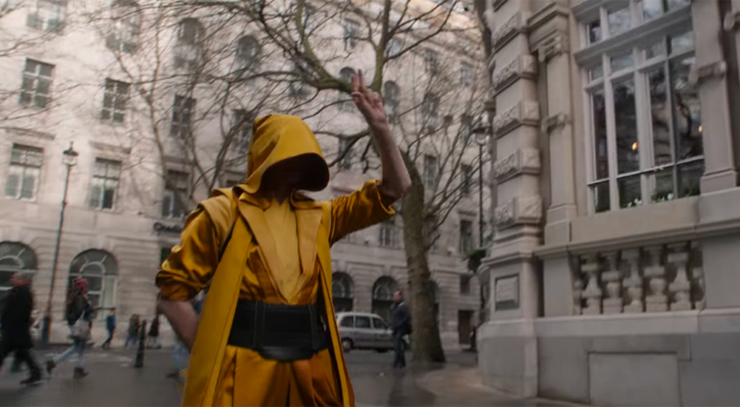
In Kamar-Taj, a haven for sorcerers under the tutelage of the Ancient One, a former acolyte, Kaecilius, along with several of his followers, invade the library, behead the librarian, and remove the pages from the Book of Cagliostro. The Ancient One confronts them, and holds her own against them. Kamar-Taj has portals to three sanctums: in London, Hong Kong, and New York. Kaecilius and his people escape to the London sanctum. The Ancient One gives chase and sends them all to the mirror dimension, an adjacent, equivalent realm where the landscape can be manipulated without affecting the real world.
However, Kaecilius is able to effect an escape, having taken the instructions for a particular ritual with him.
In New York City, Dr. Stephen Strange is performing an operation while playing “name that tune” with an MP3 player on shuffle. His colleague (and ex) Dr. Christine Palmer calls him to consult on a case in the ER: Dr. Nicodemus West has called someone dead, and Palmer doesn’t think so, but needs a second opinion. Sure enough, the patient is still alive, and Strange saves him, to West’s abashed annoyance.
Palmer tries to convince Strange to work in the ER, but he’s not interested in saving one life at a time, he’s interested in cutting-edge surgery that has the potential to save hundreds of lives. Strange then tries to convince Palmer to be his date for a speaking engagement, but she’s not interested, telling him that she never enjoyed doing it when they were dating, because it was always all about him.
He drives off to his speaking engagement, which apparently involves driving his sports car on a mountain road—which means it has to be in western New Jersey or eastern Pennsylvania, as there are no roads like that anywhere near New York—and it also starts raining. His assistant is providing him with possible cases, and when he finds one he likes after rejecting several, the assistant sends him the images to his phone. He glances down at them, taking his eye off the road, hits another car, spins out, and goes flying over the cliff.
He’s airlifted to the same hospital where he practices, which is weird, as you’d think they’d bring him closer to where he crashed, but whatever. He has catastrophic nerve damage to his hands, which means he’ll never be able to perform surgery again. Over the course of his recovery, he researches and proposes several experimental treatments, which either don’t work or are too risky for any surgeon to try. During physical therapy, Strange rejects the encouragement of the therapist, asking if he’s ever seen anyone come back all the way from an injury this bad. To Strange’s skepticism, the therapist tells him about a guy who had a shattered spine, who he later bumped into on the street walking around. Strange doesn’t believe him and demands to see the file. The therapist says it’s in the archives, but he’s willing to dig it up to shut Strange’s arrogant ass up.
Palmer has been trying to help him, but he doesn’t want her pity, and he eventually throws her out of his apartment.
Strange gets a copy of Jonathan Pangborn’s file, with a postit from the physical therapist saying, “TOLD YOU SO!” Strange tracks Pangborn down, where he’s playing a pickup basketball game. Turns out Strange was one of the surgeons Pangborn went to for treatment, but Strange turned him down. Pangborn said he went to a place called Kamar-Taj in Nepal.
Having burned through his savings, Strange spends the last of his cash to get himself to Kathmandu, where he searches for Kamar-Taj. Eventually, he’s mugged for his watch—one that Palmer gave him when they were dating—but he’s saved by Mordo, who takes him to Kamar-Taj.
It turns out to be a ramshackle structure down an alley, but it’s much bigger inside. He meets the Ancient One, who tells him about magic—truly, the manipulation of energy. In the past they called it “spells,” but the Ancient One says that you can also think of it as the source code for the universe.
Strange is skeptical right up until the part where she forces Strange’s astral form out of his physical body. She then sends his astral form on a journey through the multiverse.
And then she kicks him out, because he’s too arrogant and too skeptical and too hidebound in his view of the world.
At the end of his rope, Strange just sits outside the entrance, as he has nowhere else to go. The Ancient One eventually lets him back in and starts training him. He learns martial arts and is shown the ways of manipulating magic, though he struggles with the latter. However, he also makes use of the library, surprising Wong, the new librarian, with how quickly he is going through the tomes.
The hardest thing for him to learn is manipulating a “sling ring,” which can open portals that enable you go anywhere in the world instantly. The Ancient One tries to make him understand that he can only control the sling ring by surrendering control—which makes no sense to the very rationalist Strange, but the Ancient One explains that not everything does make sense.
She opens a portal to Mount Everest and abandons Strange there. He has to get back on his own. She and Mordo wait for him, Mordo muttering, “Not again,” making one wonder how many neophyte sorcerers are lying dead of hypothermia on Everest.
But Strange finally manages to activate his sling ring and make it back. After that, he uses his sling ring to take books out of the library and studies on his own rather than working with the teachers. The Ancient One and Mordo each castigate him for his arrogance.
Strange looks at the Book of Cagliostro, and notices the missing pages. Mordo and Wong also each tell him about the different artifacts, including the Eye of Agamotto, which can manipulate time.
He also learns about Kaecilius. One of the many dimensions in the multiverse is the Dark Dimension, ruled by a powerful being named Dormammu. Kaecilius serves Dormammu, wanting to achieve immortality by having Earth be the latest realm to be absorbed into the Dark Dimension.
Strange experiments with the Eye after reading a text about it, and is able to alter an apple from being half-eaten to all eaten to uneaten. He also reconstructs the lost pages of the Book of Cagliostro, and is able to read the ritual that Kaecilius stole.
Mordo and Wong yell at him for messing with the Eye—didn’t he know the consequences? But he only read about how to work the spell, apparently the texts put the warnings after the spell, which Strange criticizes as a method of structuring the instructions. The sorcerers point out that they’re fighting a war, protecting the Earth against mystical threats, just as the Avengers protect the world from physical ones. Strange is not happy about this—he didn’t sign up to fight a war, he’s in this to cure his hands.
Kaecilius attacks and destroys the London sanctum in order to weaken Earth’s protection to pave the way for Dormammu. The backwash of that attack sends Strange careening through the portal to the New York sanctum, which is also Kaecilius’s next stop. They kill the guardian of that sanctum, and attack Strange also, but the cloak of levitation—one of many artifacts on the sanctum’s upper floor—comes to his aid and bonds with him. Strange is able to imprison Kaecilius and sends one of his acolytes to the desert. The third sorcerer, though, stabs Strange. The cloak keeps the sorcerer occupied while Strange uses his sling ring to go to the ER to be treated by Palmer—who is rather shocked to see him after so long. (He made many attempts to contact her while in Kamar-Taj, but she didn’t reply to any of them.) She is skeptical about what he’s been up to, as it sounds like a cult—but then his astral form leaves his body and talks to her, which freaks her completely out. But it also enables him to consult on his own surgery—but then the sorcerer who attacked him, whose physical body is still being restrained by the cloak, attacks him on the astral plane.
As the astral battle goes on, Strange’s physical form flatlines. Palmer gives him electroshock, which starts his heart—but the energy of the shock transmits to his astral form, blasting outward at his foe. Strange tells Palmer to hit him again with a higher charge, which takes out his foe’s astral form, killing the body.
Strange takes his leave of Palmer—who sees him step through a sling-ring portal to the New York sanctum—and returns to find his foe’s physical form dead, Kaecilius escaped, and the Ancient One and Mordo wondering what happened. Strange tells them, and also is noticeably upset about having killed someone—he took an oath to do no harm, to save lives, not take them. Mordo explains that he doesn’t always have that option, which Strange refuses to accept.
The Ancient One is shocked to learn that Kaecilius can manipulate the landscape in the real world, not just in the mirror dimension. Mordo is shocked when Strange—who read the entire ritual that Kaecilius stole—says that the Ancient One is also drawing power from the Dark Dimension. Mordo refuses to accept that, though the Ancient One doesn’t deny it, either. The Ancient One also declares that Strange will be the new caretaker of the New York sanctum.
Kaecilius returns with reinforcements and attacks again, but this time Strange sends them all to the mirror dimension, so at least the people of New York will remain safe. However, the Ancient One, Mordo, and Strange get their asses kicked. (At one point, Strange and Mordo are thrown against a bus window, but the passenger sitting by that window, who looks just like Stan Lee, can’t see or hear them, and besides, he’s engrossed in reading Aldous Huxley’s The Doors of Perception, which is probably the best in-joke out of any of Lee’s cameos—yes, even better than the Mallrats one in Captain Marvel.) The Ancient One is badly wounded, and Strange takes her to the hospital. Palmer and West work on her—Strange actually picks up a scalpel, but his hands still shake too much, so he tells West to take over. Her astral form abandons her body, and Strange does likewise.
The Ancient One admits that she has peered into many possible futures, but none go past this moment—she is, she knows, fated to die now. She reveals to Strange that she didn’t cure Pangborn—instead, he uses magic, constantly, to keep himself mobile. She has seen many possible futures for Strange, and she hopes he’ll follow the best path that will lead to him becoming the great sorcerer he has the potential to become.
Her final advice to Strange before she dies is to admit that she did draw power from the Dark Dimension, because sometimes you need to break the rules. Mordo doesn’t understand this, as he is too rigid in his thinking. Strange needs Mordo’s strength and purity of purpose, and Mordo needs Strange’s improvisational skills.
Kaecilius’s next target will be the Hong Kong sanctum. Wong has gone ahead with various other mystics to defend it. Strange and Mordo head there, only to find that the Hong Kong sanctum has fallen. Using the Eye, Strange reverses time, keeping himself and Mordo immune to the shifting of the timestream. However, Kaecilius and his acolytes’ connection to the Dark Dimension makes them just as immune, so they continue to fight even as time reverses itself around them. Once they go to before Wong’s death, Strange protects him from the time changes as well, and the three of them confront Kaecilius’s forces—only for Kaecilius to freeze time right before/after the Hong Kong sanctum starts to fall.
Strange decides to go straight to the source. He has the Eye put himself in a time loop where he goes to the Dark Dimension and says, “Dormammu, I’ve come to bargain.” When he dies, the loop resets itself. Dormammu keeps killing Strange, telling the sorcerer he can’t win. But Strange can lose—again and again, and as long as he does, the people of Earth are safe.
Dormammu finally breaks down and asks Strange to free him from the trap, which Strange will only do if Dormammu leaves Earth alone forever. He agrees, and takes Kaecilius with him.
Strange returns to Earth a moment after he left, and Kaecilius and his people are dragged to the Dark Dimension to suffer torments forever. Strange’s last words to Kaecilius are that he should’ve stolen the whole book—the warnings are after the spells…
Mordo is disgusted by the Ancient One drawing on the Dark Dimension to make herself immortal, and equally disgusted by Strange’s blithe manipulation of time. He walks away from Strange and Wong, declaring himself to be done with Kamar-Taj.
Strange puts the Eye of Agamotto back on its pedestal in Kamar-Taj, with Wong only then revealing that it’s an infinity stone—a meaningless designation to Strange, but a significant one to the audience.
We jump ahead a few months to see Thor visiting Strange in his sanctum, the thunder god asking for help in finding Odin. Elsewhere, Mordo has decided that there are too many sorcerers, and he’s going to remove the power from all those who are misusing it—he starts with Pangborn.
“Study and practice—years of it”
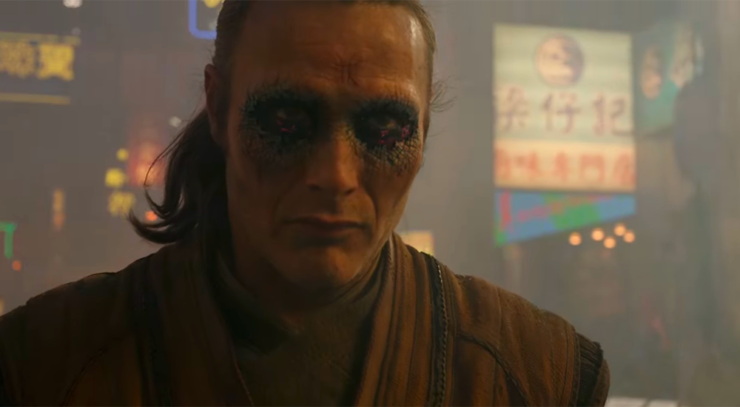
This has all the makings of a great movie, and it frustrates the hell out of me that it’s merely a good one.
The overall story is fine. It’s a good introduction to the use of magic in the MCU, one that still works within the very scientific-minded bent of previous movies. (The source-code metaphor is a good one.) It’s just a different way of manipulating energy—Tony Stark uses armor, Stephen Strange uses magic. The actual plot of saving the world from being absorbed into the Dark Dimension is a worthy one for Strange’s first movie outing.
And the casting is mostly superb. Nobody ever went wrong casting Benedict Cumberbatch in anything, as he’s proven he can play any role he’s handed. While his performance isn’t quite perfect—for reasons I’ll get into in a bit—I do like that he portrays Strange as smart. He figures out how to do things, and he gets better with practice—you see the process by which he learns and improves himself as the movie goes on.
Chiwetel Ejiofor is superb as Mordo, one who is less of a mustache-twirling villain than his comics counterpart, and who comes by his villainy honestly over the course of the film by the betrayals he sees in the way things are supposed to be. He’s set up very nicely to be a bad guy in a followup film, though whether that’s in the upcoming Doctor Strange in the Multiverse of Madness or elsewhere (or at all) remains to be seen.
Benedict Wong and Rachel McAdams are both excellent. McAdams has a particularly thankless task, but she and Cumberbatch both salvage it by playing Palmer and Strange as having a strong friendship that has its basis in a disastrous love affair. These are two people who know everything about each other, and would always be there for each other (well, she’d be there for him, at least), but can’t stand to live together long term. The easy camaraderie and banter the pair of them have is very real and convincing, and it makes for a strong friendship that you rarely see between opposite-sex characters. And Wong is a delight, a steady dependable rock.
Tilda Swinton is, of course, brilliant, but her casting is problematic. I understand why they didn’t want to go for the “ancient Asian master” stereotype, but they went a little too far with it. Kamar-Taj is located in Asia and is apparently populated by very few Asians. Some background characters, sure, but the person running the place is an ancient Celt? Really? And no speaking characters who are actually from India?
The timeline of this movie is a big problem. There’s simply no way this story can happen in the time allotted. At the very beginning, Strange has an award that is dated 2016, the same year the movie came out. But then he’s in the accident, he has to recover, and then he has to research cures, then he has to hit rock bottom, then he has to go to Kamar-Taj, then he has to learn the mystic arts, and there’s no way this didn’t take at least a few years. Yet he’s a fully formed master of the mystic arts in Ragnarok and Infinity War, which take place in 2017 and 2018, and that just does not work. This is all stuff that takes time, and there’s no indication in the movie that he’s taking it. (One can ignore that shot of a 2016 award before the car accident and assume that the opening of the movie takes place in 2013, which would track with Strange still being a surgeon in 2012, as established in Endgame, and the climax of the film takes place three years later, which actually provides enough time for all of this to happen.)
The biggest problem, though, is the same one that Justice League had. The first JL story should’ve had Darkseid as the bad guy, not an obscure minion of Darkseid. By the same token, Dormammu should be the main bad guy here, not some dim-bulb minion, whom Mads Mikkelsen imbues with precisely no personality whatsoever. Worse, they turn Dormammu into a CGI creature also with no personality whatsoever, whom we don’t even see until the climax.
Which is too bad, because the climax is brilliant. Obviously inspired in part by Dormammu’s first confrontation with Strange in the classic Strange Tales #126-127 back in 1964—where Dormammu winds up in debt to Strange for helping him—Strange using the Eye to trap the bad guy in a time loop is just fantastic.
And it points up to an important part of Strange’s character, which is one of the things I like best about the movie: Strange doesn’t wish to kill. He’s forced into it once, and he hates it and doesn’t want it to happen again. He wants to save lives. One of the tensions between Hollywood action movies’ proclivity for death and destruction and adapting superhero comic books is that most superheroes don’t kill—it’s part of what makes them actual heroes as opposed to vigilante shitheads. Far too many movies in this rewatch have ignored or lost sight of that particular truism (the 1989 Batman, Iron Man 3, Man of Steel, the 2003 Daredevil), but not Doctor Strange, thank goodness. He sends the second battle with Kaecilius in New York to the mirror dimension, and he puts himself in Dormammu’s fatal line of fire indefinitely, in both cases to safeguard the lives of the people of Earth.
The characterization of Strange is also problematic. As I said, Cumberbatch makes it work, because that’s his super power, but turning Strange into Yet Another Snarky White Guy (just like Iron Man, the kids’ll love it!) who loves classic rock (just like Star Lord, the kids’ll love it!) feels horribly constructed. The Strange of the comics is a staid, eloquent sort, and I would much rather have seen Cumberbatch play that Strange than a clone of Tony Stark and Peter Quill.
And the Eye of Agamotto is an infinity stone. Sigh. In the comics, the Eye is the all-seeing eye that shines a bright light that casts out artifice. Here, it’s a time machine, which makes for a clever climax, but it’s also not gonna be seen again, since the infinity stones were all taken care of in the next two Avengers movies. And heaven forfend we have an MCU character who isn’t connected to the infinity stones…
Then we have the sling rings. Jesus fucking Christ, the sling rings. What an idiotic addition those are. Yes, let us master the mystic arts, let us access the source code of the universe, let us surrender control to gain control—and oh yes, let’s also make sure we never lose our +5 Teleport Ring, otherwise the party can’t get to the next dungeon in the campaign. This is a corner of Marvel that has given us the Eye of Agamotto, the Crimson Bands of Cyttorak, the Winds of Watoomb, the Book of Vishanti, the Flames of Faltine, the Hoary Hosts of Hoggoth—and now, the sling ring. One of these is not like the other. I remember watching this movie in the theatres and thinking that this was a directive by Disney so they could market sling rings in toy stores in 2016, which is the only way that these doofy accessories fit in with the rest of it.
I’ve been slagging the movie a lot, but for all that I’m complaining about the details, the overall movie is fun and enjoyable, and a good introduction to an important character in the Marvel pantheon. While Scott Derrickson and his collaborators’ script has its flaws, his direction is superb. The performances are all fantastic (with the exception of Mikkelsen), the action is brilliant and kinetic and evocative, and the Escher-by-way-of-Inception kaleidoscopic visuals are beyond stunning. It’s a very enjoyable movie in the abstract, and I’m very much looking forward to more Doctor Strange in the MCU going forward.
Next week, we find out why Thor is visiting Doctor Strange in Thor: Ragnarok.
Keith R.A. DeCandido wonders how many people have been using “shambala” as their wifi password the last three years.


